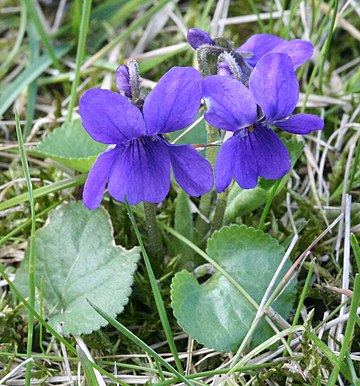
Native to Europe and Asia, the sweet violet is a herbaceous perennial belonging to the plant family Violaceae, that also includes pansies and johnny jump ups. It grows 4-10″ tall and has a basal rosette of dark green heart-shaped leaves that are 1-3″ long and have toothed margins. Fragrant flowers appear in late winter to spring and are typically purple to dark blue, but may be white lilac, or rose. Each flower is 1/2″ across and has 4-5 petals with the lowest petal larger than the others and spurred. In the summer a second kind of flower appears. It lacks petals, is self pollinated, and produces seed capsules that spew the small seeds considerable distances.
Violets have been known since ancient times and both the Greek Herodotus and the Roman Pliny wrote about their medicinal qualitative. Violets used to be widely used in perfumes but is now used only for very high quality ones. They can be used in potpourris but the odor is not long lasting. A better use is as a garnish for chilled soups and punches or added to salads, puddings, jellies and jams. The flowers and leaves can be steeped in water and used in cupcakes, tea breads, puddings, and ices. Commercial hybrids make especially nice garden plants with their large flowers and various colors and are a good choice for beds, borders, underplanting of shrubs, cottage gardens, rock gardens, and containers. If they like their location than can become a bit rambunctious but add attractive clumps of leaves to the garden border even after their flowers die down.
The genus name, Viola, was the Latin name for one species of the genus. The specific epithet, odorata, is Latin word meaning fragrant.
Type: Herbaceous perennial.
Bloom: Solitary dark blue to purple 5-petaled flowers from late winter to spring
Size: 4-10” H
Light: Full sun to mostly shade (full sun only with cool temperatures and adequate moisture).
Soil: Humus-rich, consistently moist, well drained
Hardiness: Zones 4-9.
Care: Deadhead to prolong bloom; cut back in fall to improve spring bloom.
Pests and Diseases: Susceptible to red spider mites, slugs, snails, violet gall midge, pansy leaf spot and powder mildew.
Propagation: Self sows and spread by means of stolons; seed or division.
Outstanding Selections:
‘Alba’ (white flowers)
‘Clive Groves'(dark purple flowers
‘Queen Charlotte’ (spreading up to 2′)
‘Rosina’ (rose colored flowers)
‘Wellsiana’ (mat-forming; dark purple flowers)
Photo Credit Wikipedia
